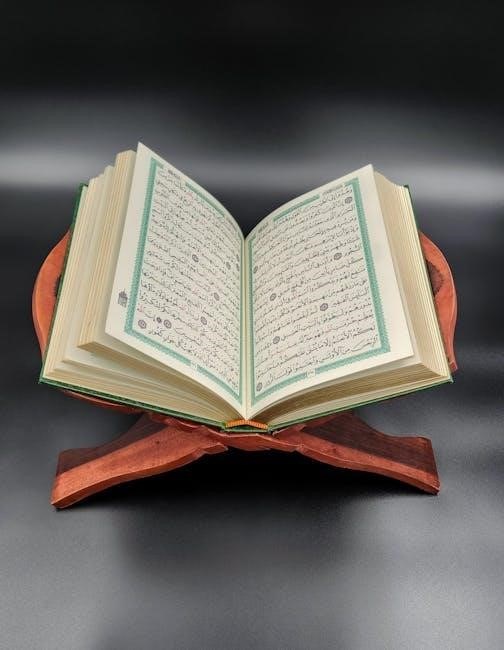Rudolfo Anaya’s seminal novel, Bless Me, Ultima, published in 1972, is a cornerstone of Chicano literature, exploring themes of faith, identity, and cultural heritage through Antonio Márez’s journey.
Background and Significance of the Novel
Rudolfo Anaya’s Bless Me, Ultima, published in 1972, holds a pivotal place in Chicano literature. This semi-autobiographical novel reflects Anaya’s own experiences, blending cultural heritage with personal identity. Its exploration of faith, tradition, and coming-of-age themes has made it a cornerstone in educational curricula. The novel’s impact extends beyond literature, inspiring adaptations like an opera. Awarded the Quinto Sol National Chicano Literature Award in 1972, Bless Me, Ultima continues to resonate, fostering discussions on cultural identity and spirituality.
Overview of the Author, Rudolfo Anaya
Rudolfo Anaya, born in 1937 in New Mexico, is a celebrated author and a key figure in Chicano literature. His works often explore cultural identity, spirituality, and the blending of folklore with modern life. Anaya earned a master’s degree in literature and taught in New Mexico before dedicating himself to writing. His contributions to Chicano literature have been recognized with numerous awards, including the Quinto Sol National Chicano Literature Award. His writing continues to inspire new generations of readers and scholars alike.

The Author and His Work
Rudolfo Anaya’s work, including Bless Me, Ultima, is a cornerstone of Chicano literature, blending cultural identity, spirituality, and folklore, inspiring readers and scholars with its profound themes and rich storytelling.
Rudolfo Anaya’s Background and Contributions to Chicano Literature
Rudolfo Anaya, a pivotal figure in Chicano literature, was born in 1937 in New Mexico. His semi-autobiographical works, such as Bless Me, Ultima, reflect his cultural heritage and spiritual explorations. Anaya’s writing often blends folklore, mythology, and personal experience, offering profound insights into the Chicano identity. His contributions have been instrumental in shaping the literary movement, earning him acclaim and recognition. Anaya’s work continues to resonate, influencing scholars and readers alike with its rich storytelling and cultural depth.
Other Notable Works by Rudolfo Anaya
Beyond Bless Me, Ultima, Rudolfo Anaya’s notable works include Heart of Aztlan and Tortuga, which explore themes of identity and cultural resilience. His novel Alburquerque delves into the city’s history and myths, while The Curse of the ChupaCabra blends folklore with contemporary issues; Anaya also wrote essays and children’s books, showcasing his versatility. His contributions to Chicano literature have cemented his legacy as a storyteller and cultural preservationist, inspiring future generations to explore their heritage through his works.
Plot Summary of “Bless Me, Ultima”
The novel follows Antonio Márez’s coming-of-age in New Mexico, exploring his spiritual growth under Ultima’s guidance and the clash between tradition and modernity;
The Setting and Its Importance
The novel is set in post-World War II New Mexico, where Antonio Márez grows up in a culturally rich but conflicted environment. The rural landscape, with its vast plains and mystical elements, mirrors Antonio’s internal struggles and spiritual journey. The setting reflects the blending of Spanish, Native American, and Catholic traditions, emphasizing the cultural duality faced by Chicano communities. The time period and location are crucial, as they shape Antonio’s experiences, identity, and understanding of faith, heritage, and the world around him.
Key Characters and Their Roles
Antonio Márez is the young protagonist, navigating identity, faith, and cultural duality. Ultima, a wise curandera, guides Antonio’s spiritual journey, teaching him about tradition and healing. Antonio’s parents, María and Gabriel, represent opposing influences: María’s Catholic devotion and Gabriel’s restless spirit. The character of Tenorio Trementina embodies evil, challenging Ultima’s power. These figures shape Antonio’s understanding of his world, blending folklore, family, and spirituality into his formative experiences, making them central to the novel’s exploration of heritage and self-discovery.

Themes and Symbols in the Novel
The novel explores themes of faith, identity, and cultural heritage. Ultima symbolizes wisdom and spirituality, guiding Antonio’s journey. The river represents life’s cycles and transformation, linking tradition and renewal.
Exploration of Faith and Spirituality
Bless Me, Ultima delves into Antonio’s spiritual awakening, blending Catholicism with indigenous traditions. Ultima, a curandera, embodies mystical healing and wisdom, guiding Antonio’s journey. The Virgin of Guadalupe symbolizes maternal faith, while Ultima’s teachings challenge Antonio’s Catholic upbringing. The novel explores the tension between organized religion and natural spirituality, reflecting the cultural duality of Chicano identity. Through rituals and symbolic elements like the river and moon, Anaya illustrates the transformative power of faith and the search for divine meaning in a fragmented world.
The Concept of Identity and Cultural Heritage
Bless Me, Ultima explores Antonio’s struggle to reconcile his Spanish and indigenous roots, reflecting the duality of Chicano identity. Ultima embodies the wisdom of his ancestors, guiding Antonio through cultural and spiritual traditions. The novel highlights the clash between modernity and heritage, as Antonio navigates the expectations of his family and the evolving world around him. Through symbolic figures like the Virgin of Guadalupe and Ultima, Anaya underscores the importance of preserving cultural identity while embracing change, resonating deeply with Chicano readers seeking to understand their own heritage.

Cultural Significance of “Bless Me, Ultima”
Bless Me, Ultima holds profound cultural significance as a landmark of Chicano literature, sparking the Chicano literary movement and inspiring cultural pride. Its exploration of identity and heritage resonates deeply with Mexican-American communities, making it a vital work for understanding cultural duality and resilience.
The novel’s recognition, including the Quinto Sol National Chicano Literature Award, solidifies its impact. Its adaptation into an opera further highlights its enduring relevance, ensuring its message of cultural preservation and identity continues to resonate across generations.
Impact on Chicano Literature and Identity
Bless Me, Ultima is celebrated as a foundational text in Chicano literature, sparking a literary movement in the 1970s. Writer Tony Hillerman hailed Rudolfo Anaya as the “godfather and guru of Chicano literature,” emphasizing his pivotal role. The novel’s exploration of cultural identity, faith, and heritage resonated deeply with Mexican-American communities, fostering pride and a renewed connection to their roots. Its inclusion in school curricula and recognition with the Quinto Sol National Chicano Literature Award further solidified its influence, making it a cornerstone of cultural and literary identity.
Reception and Recognition in Academic Circles
Bless Me, Ultima has received widespread academic acclaim for its rich cultural insights and literary depth. Scholars praise its exploration of identity, faith, and tradition, making it a cornerstone of Chicano studies. The novel earned the Quinto Sol National Chicano Literature Award in 1972, solidifying its status as a seminal work. Its inclusion in school curricula and university syllabi underscores its enduring relevance. Academic analyses frequently highlight its nuanced portrayal of Mexican-American experiences, cementing its place in literary and cultural scholarship.

Availability and Access to the Book
Bless Me, Ultima is widely available in digital formats, including PDF and EPUB, from various online platforms. Print editions are published by Warner Books and Tonatiuh-Quinto Sol.
PDF Versions and Digital Availability
Digital versions of Bless Me, Ultima are widely accessible, with PDF and EPUB formats available for download. An EPUB file was released in 2018, offering a convenient reading experience. Platforms like ResearchGate provide access to interactive PDFs, enabling easy sharing and embedding. Additionally, digital downloads are offered through various online retailers, making the novel accessible to a global audience. However, readers are encouraged to obtain copies from authorized sources to ensure quality and legality. This digital availability has significantly expanded the novel’s reach and accessibility.
Print Editions and Publishing History
Bless Me, Ultima was first published in 1972 by Warner Books, marking Rudolfo Anaya’s debut novel. The book has since been released in multiple print editions, including a 1995 Warner Books edition and a version by Tonatiuh-Quinto Sol in Berkeley. The University of New Mexico Press also published it in 1988. This seminal work in Chicano literature has remained widely popular, with its enduring themes and cultural significance ensuring its continued publication and inclusion in educational curricula nationwide.
Adaptations and Interpretations
Bless Me, Ultima has been adapted into an opera, showcasing its cultural significance. The National Hispanic Cultural Center in Albuquerque has played a key role in this interpretation.
The Novel’s Adaptation into an Opera
Bless Me, Ultima was transformed into an opera, premiering at the National Hispanic Cultural Center in Albuquerque. This adaptation captures the novel’s essence, blending traditional music and storytelling to convey Antonio’s journey and the mystical presence of Ultima. The opera maintains the original’s emotional depth, offering a fresh perspective on Chicano cultural themes. This creative reinterpretation has been well-received, further cementing the novel’s impact on various artistic mediums and its enduring relevance in contemporary culture.
Visual and Theatrical Interpretations of the Story
Bless Me, Ultima has inspired various visual and theatrical interpretations, enriching its narrative through stage plays, art exhibitions, and digital media. These adaptations capture the novel’s emotional depth, cultural richness, and mystical elements, offering audiences a vivid exploration of Antonio’s journey. From dramatic performances to visual art, these interpretations highlight the universal themes of identity, faith, and heritage, ensuring the story’s relevance across diverse artistic mediums and generations.

Reception and Reviews
Rudolfo Anaya’s Bless Me, Ultima received critical acclaim, winning the Quinto Sol National Chicano Literature Award in 1972; It is now part of American high school curricula.
Critical Acclaim and Scholarly Reviews
Bless Me, Ultima has garnered widespread critical acclaim for its rich storytelling and cultural depth. Scholars praise its exploration of Chicano identity, faith, and tradition, hailing it as a seminal work in Chicano literature. The novel’s magical realism and vivid portrayal of New Mexico’s cultural landscape have been particularly celebrated. Its impact extends beyond literature, as it is often credited with sparking the Chicano literary movement. Academic circles recognize its significance, incorporating it into curricula to explore themes of identity and heritage. Its enduring relevance ensures continued scholarly analysis and appreciation.
Awards and Recognition Received
Bless Me, Ultima earned the prestigious Quinto Sol National Chicano Literature Award in 1972, solidifying its place as a landmark in Chicano literature. This recognition highlighted its cultural significance and literary merit. The novel’s impact continues to be celebrated, with scholars and readers alike acknowledging its enduring influence. Its inclusion in academic curricula further underscores its importance, ensuring its legacy as a foundational text in American literary studies. The award marked the beginning of its widespread acclaim and lasting impact on literary circles.

Educational Use and Analysis
Bless Me, Ultima is widely studied in schools, exploring themes of cultural identity and faith. Its rituals and heritage are key analysis points.
Curriculum Inclusion in Schools
Bless Me, Ultima is widely incorporated into high school and college curricula for its rich cultural insights and universal themes. Educators value its exploration of identity, faith, and heritage, making it a vital text for understanding Chicano experiences. The novel’s accessible language and deep thematic complexity encourage critical thinking and discussions about cultural assimilation. Its inclusion in educational programs highlights its significance in American literature, providing students with a bridge to explore diverse perspectives and historical contexts. PDF versions and study guides further support its educational use.
Analysis of Rituals and Cultural Practices
In Bless Me, Ultima, Rudolfo Anaya intricately weaves rituals and cultural practices, reflecting the rich tapestry of Chicano heritage. Ultima, a curandera, embodies traditional healing and spirituality, blending indigenous and Catholic elements. Her rituals, such as cleansing ceremonies and herbal remedies, highlight the interconnectedness of faith and nature. These practices not only shape Antonio’s identity but also serve as a bridge between generations, preserving cultural traditions. The novel’s exploration of these rituals offers insights into the resilience of cultural heritage and its role in navigating identity and belonging.
